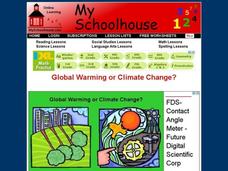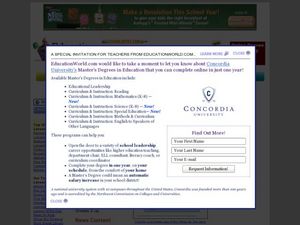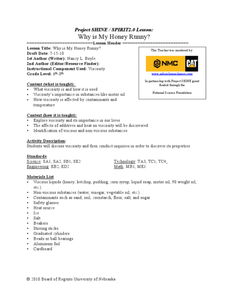Curated OER
Ocean Currents Quiz
In this ocean worksheet, students complete a 13 question multiple choice on-line interactive quiz about ocean currents. Prior knowledge is assumed.
Curated OER
Hot Friction
Sixth graders use small electronic devices known as thermistors to measure the temperature beneath an object such as a coffee cup as it slides across a surface. By choosing different surfaces, 6th graders can compare in a quantitative...
Curated OER
Solids
In this solids worksheet, students review terms associated with solid matter including, freezing and melting point, viscosity, and Brownian motion. This worksheet has 1 short answer and 14 matching questions.
Curated OER
Miscellaneous Light Topics
In this light topics science worksheet, students read selections about fiber optics, fluorescent light, incandescent light, total internal reflection, polarization, glow-in-the-dark light, and lasers. Students then respond to 32...
Curated OER
Hard Water
In this water worksheet, students read how hard water is created and what can be done to soften the water. Then students complete 6 short answer questions.
My Schoolhouse
Global Warming or Climate Change?
In this online interactive global warming and climate change worksheet, students respond to 10 multiple choice questions regarding the information included in the provided paragraphs.
Curated OER
Global Warming or Climate Change?
In this online interactive global warming and climate change instructional activity, students respond to 10 multiple choice questions regarding the information included in the provided paragraphs.
Curated OER
Knowledge Quiz
In this oceans quiz instructional activity, students complete a 10 question multiple choice quiz covering a variety of concepts related to the ocean.
Curated OER
Tides and Currents
Students research and describe how currents are formed. In groups, they relate specific terms to the formation of currents and locate different currents on a world map. They also examine tides, how they are formed and how they are...
Curated OER
Ocean Currents
Learners discover the geography of Earth by analyzing water currents. In this oceanography lesson, students create visual references on a map of the globe where and why major ocean currents are moving water. Learners conduct a water...
Curated OER
Global Winds
Students extend their understanding of convection to consider global winds and the effect of the earth's rotation on the creation of patterns of prevailing wind direction.
Curated OER
Classification of Clouds
Students view progressive slides of cloud formations and identify which type of cloud is shown as it forms. They estimate the cloud's height while viewing each image.
Curated OER
Motions and Forces
Students explore motions, forces and magnetism. They investigate magnetism as a force and examine the construction of a magnet. Students examine the force that magnetism produces.
Curated OER
Newton's First Law
For this friction worksheet, students will read about fluid friction and examples of fluid friction. Students will also explore the role fluid lubricants have in reducing friction between two surfaces. Then students will answer two short...
Curated OER
Light Bulbs Save Energy
Students read a story called New Bulbs Provide More Light, Save Energyand answer vocabulary and comprehension questions about it. In this current events energy saving light bulb lesson plan, students respond to literature by answering...
Curated OER
Solids and Liquids
Students complete activities to study the properties of solids and liquids. For this states of matter lesson, students investigate the melting and freezing of a range of materials in a virtual experiment. Students melt the substances and...
Curated OER
Why is My Honey Runny?
Students identify the factors that affect viscosity of substances. For this chemistry lesson, students define what viscosity is in their own words. They give real world applications of viscosity.
Curated OER
Electricity Safety
Third graders explore electricity safety. In this science lesson plan, 3rd graders read a story about an electrical outage. Students discuss if various situations shown are safe or unsafe.
Curated OER
Metalloids
Students discuss metalloids, their use as semiconductors, and their impact on the computer industry. They work in groups to create a visual timeline showing the evolution of the computer.
Curated OER
Plate Tectonic - Volcanoes Post Lab
First graders draw an erupting volcano. They learn the components of an erupting volcano.
Curated OER
The Atmosphere and Flight
Learners investigate evaporation and condensation, and apply the concepts to understanding cloud formation.
Curated OER
Insulators, Conductors, and Energy Transfer
Third graders conduct experiments to determine what types of material make good insulators. They prepare a graph of time vs. temperature for their sample. They choose a graph using each kind of material to display for class analysis and...
Curated OER
Connect the Species
Fourth graders, in pairs, explore energy transfer and species interrelationships by viewing slides on a microscope. hey explore phytoplankton (producers) and zooplankton (consumers)
Curated OER
What's the Difference?
Students discover how volcanic processes differ at convergent and divergent tectonic plate boundaries. They identify three geologic features that are associated with most volcanoes on Earth.
Other popular searches
- Flow of Heat
- Earths Heat Flow
- Heat Flow Hands On
- Energy Waves Heat Flow
- Heat Flow Work
- Measure Heat Flow
- Temperature Flow of Heat

























